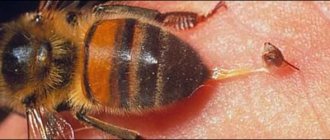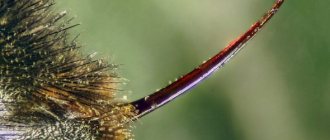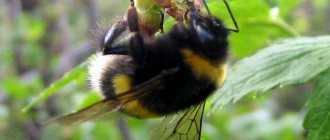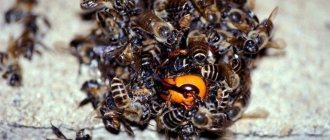Bees Blog Articles
Beekeeping
Economics of beekeeping
Beekeeping news in Russia
Beekeeping news in the world
Honey
Propolis
Bee bread
Zabrus
Royal jelly
In the world about bees
Apiary
Bees
News from honey fairs
From the history of beekeeping
- What is the structure of a bee's eyes?
- Features of the eyes of the queen, drone, worker bee
- Bee vision mechanism
- The location and number of eyes of a bee
- Why exactly so many eyes?
- Color perception of the world through the eyes of bees
- Can bees see in the dark?
- What happens if you blind a bee with a bright light?
What is the structure of a bee's eyes?
To the unusual question about how many eyes a bee has, we immediately answer: “There are only five eyes, 3 simple, and 2 complex, consisting of facets.” Bees have a complex visual system. It unites various organs of the visual apparatus, which are responsible for performing certain functions.
Such organs help bees navigate in space, compensate for insufficient illumination, and allow them to smell flowering at a distance of up to 1 km. They are not only responsible for the perception of the environment, but also perform additional functions. The working honey bee has eyes with a complex structure on the sides of its head. They are formed by a huge number of special cells. They are called facets. Bees see their surroundings as a mosaic made up of tiny particles. Each facet is responsible for forming its own part of the picture.
The structure and location of bees' eyes
The head of a bee is a hard capsule. Upon magnification, it is revealed that the honey bee has eyes not only on the sides, but also on the back of the head capsule. There are a total of five eyes on a bee.
Let's look at the structure of complex and simple eyes in more detail. Oval large eyes are called facet eyes. These are a pair of complex visual organs. Simple ocelli located on the parietal part of the capsule are also called ocelli. These are those eyes that contain no more than one lens.
It is believed that the additional triangle of eyes is of an auxiliary nature. Simple eyes help hardworking insects distinguish morning from evening and perceive the intensity of lighting in space.
As it has already turned out, the striped insect has complex vision. Of the five eyes, two multifaceted eyes are of particular interest. They are also called compound eyes - they represent about six thousand independent cells. In drones, the number of such independent eyes is approximately eight thousand. This is due to their functionality.
Important! The drones' job is to carefully monitor the queen during the mating season in the hive. It is for this reason that they have more complex vision than honey bees.
Insects have compound eyes that resemble honeycombs. They consist of individual eyes - hexagons located on the surface of the facet eye. A separate cell is called ommatidia.
Each of them consists of 8–9 oblong optic cells, which have a thin border directed inside the bundle itself. In the process of combining the border, a glassy axis is formed. In it, light stimuli are processed through receptors using a chitinous lens and a crystal cone. Ommatidia are separated from each other by pigment cells.
This is interesting! How organelles are structured: structure and functions of plant and animal cell organelles
Individually, each cell is capable of capturing only those rays that run parallel to the axis. By summing the rays from all ommatidia, the final appearance of the uninverted image is obtained. The sharpness of the image of an object in insects differs significantly from human visual perception.
The photo clearly shows how the environment is perceived by flying insects. Like a mosaic, the overall picture is divided into its small particles.
Features of the eyes of the queen, drone, worker bee
If you compare the visual organs of bees of different classes, you will find differences. The worker bee has simple eyes located on the crown of the head. In contrast, in the drone and queen bee such organs are located directly on the forehead. Insects have different numbers of facets (ommatidia). In queen bees their number often reaches 4,000, in worker bees - 5,000, in drones - 9,000.
The compound eyes are clearly visible in drones, since they converge on the crown of the head. In the queen bee and worker bee, it is difficult to distinguish these visual organs at a superficial glance. In all the insects described, simple ocelli have a primitive structure. These are special transparent lenses; they protrude significantly from the head. Each of them separately captures images.
How does a person react to insect venom being injected into the eye?
- With the usual type of reaction to insect venom, slight swelling develops in the area of the visual organ, redness of the skin and outer membrane of the eye appears, and the person experiences pain.
- Sometimes the local reaction can be more pronounced. In this case, the eye area swells by 5 cm in diameter and severe swelling and pronounced redness of the mucous membranes and skin occur.
- Some people, in addition to the local one, develop a general body reaction to a sting. It can manifest itself as malaise, the spread of the inflammatory process far from the site of the bite.
Often, those who have been bitten by a bee or wasp react to stings in the eye with allergic manifestations. They can range from mild (itching, weakness, skin rashes) to very severe conditions (suffocation, sudden decrease in blood pressure, anaphylactic shock, Quincke's edema).
The body can react sharply even if you are stung by just one insect. Multiple stings in the eye area cause a strong toxic reaction, which can not only negatively affect vision, but also be fatal.
Bee vision mechanism
If you look closely at compound eyes using a magnifying loupe, you will notice hexagonal embossing on the surface of each organ. Because of this specific embossing, the eyes are often called mesh. Any of the facets is a bundle, which consists of cells that have an elongated shape and a thin border. Between adjacent eyes there are special pigment cells.
The presence of thousands of facets does not provide bees with good vision. Regardless of environmental conditions, the image of objects remains insufficiently clear. It is divided into separate points. The special design of the binocular system imposes its own limitations. It has been proven that the eyes of bees are more adapted to the perception of objects that are in motion, in a state of flight. Vision does not cope well with the perception of objects that are motionless and do not change their location.
The visual information that bees perceive through their eyes is instantly converted into nerve impulses. They immediately enter the brain. There, first the analysis takes place, and then the processing of the received information. After the response is generated by the central part of the nervous system, the signal is transmitted to peripheral organs. Insect vision is characterized by three-dimensionality and blurred images.
The location and number of eyes of a bee
Regardless of the class of the insect (worker bee, drone, queen bee), it has five eyes. On the head of any individual are located:
- three small dorsal ocelli (ocelli);
- two large eyes with a complex structure.
The eyes of the second type are called facet eyes because they are located on the sides of the head and are formed from a huge number of facets. Such organs of vision have an oblong shape. They are bulges that point downwards.
Compounded eyes are formed from ommatidia - these are structural units. They are densely located, neighboring ommatidia are closely adjacent to each other. Each of these functional units that make up the facet organ has a refractive, insulating and receptive part.
Interestingly, the size of each honey bee eye is on average 2 millimeters. Moreover, the number of eyes remains unchanged for each individual. The visual organs of drones have the most significant area; the second place according to this criterion is occupied by working individuals, and the uterus closes the list.
Features of the structure of a bee's eyes
In a bee family, the following individuals are distinguished: drones, workers and the queen bee. They all perform different functions and therefore their eye structure is different.
Important! Bees see even very fast movements in slow motion and absolutely clearly.
By type
The honey bearer has two types of eyes: simple and complex, or facet, organs of vision:
- simple - consist of a lens. Their role is that they determine the time of day and see objects blurred or at close range;
- complex - represent a large number of hexagonal facets covered with hairs. The image is formed into a whole from many individual fragments, thanks to which the bee distinguishes between moving objects and stationary forms while moving.
Eye location
In working individuals, simple eyes are located in the form of a black triangle on the top of the head. The faceted ones are located on the sides and consist of 5 thousand segments.
The simple visual organs of the queen bee are located on the forehead. Complex insects are larger in size than those of working insects, but have a smaller number of segments (up to 4 thousand) due to the fact that the queen does not fly over large spaces.
Drones have simple eyes also on their foreheads. Faceted ones are the largest in size and number 10 thousand fragments.
Why exactly so many eyes?
Hardworking bees initially have a poorly developed visual apparatus. To compensate for their underdeveloped vision, nature has endowed them with several organs of vision. As many as five eyes allow these insects to navigate their surroundings, receive information about flowering plants, and see various objects. Large eyes help to see objects and form a holistic picture of what is happening around the insect.
The dorsal organs (ocelli) are responsible for twilight vision. They help bees learn about the approach of dawn and the onset of a new day, as well as accurately receive information about its end. Ocelli partially replace the sense of touch; they have a secondary function as part of the binocular system. The facet organs form images in the form of a mosaic, which consists of individual points and helps to obtain a holistic view of objects.
Compounded eyes with a complex structure are used as the main part of the visual apparatus. In contrast, simple eyes are considered a secondary element. They provide bees with objective information about the surrounding space.
Color perception of the world through the eyes of bees
Such insects distinguish many colors and shades. Only they do not perceive the color red, they cannot distinguish it from black. By the way, this is why all winter inspections of bees are carried out using a red flashlight; bees do not see light, which means they are less worried. Bees' images of the surrounding world are formed in the ultraviolet spectrum.
Video: This is how bees see
Adults perceive shades of white, blue and yellow best. The vision of adults can be called mosaic. Their brains do a lot of work when forming an image. The whole process looks like this:
- Each of thousands of facets perceives only one part of an object, and not the entire object.
- The brain processes incoming images depicting individual parts of an object.
- In the brain, individual parts of an object merge, and as a result, worker bees perceive the whole picture.
Bees do not see much difference between orange, green, light green and yellow colors. The visual apparatus of bees has the ability to perceive polarized light. This quality allows insects to calmly navigate in space.
Features of bee vision
According to one opinion, the bee is good at detecting movement , so you should not frighten the insect by causing it to react aggressively. And according to another version, the bee does not see moving objects well, so it flies closer to take a closer look...
Insects do not distinguish the shape of objects so well. It is best if the object resembles a flower, and geometric shapes do not cause interest.
Insects also see polarized light - light propagating in one direction, which occurs when reflected from glass, the surface of water or crystals. Therefore, they see obstacles well and navigate in space.
Video: A look at the apiary through the eyes of a bee
It is worth noting that worker bees rarely fly in the dark, with rare exceptions. This is caused not only by the need for night rest, but also by a decrease in the strength of the electromagnetic field. This factor contributes to the disruption of spatial orientation in bees, so they generally prefer not to fly at night. Experimentally, it was possible to find out that these insects are able to distinguish the shapes of objects.
What reactions are possible to a stinging insect bite?
- The usual reaction involves slight swelling in the eye area, redness of the conjunctiva and skin of the eyelid, pain and itching.
- If the area of edema in the bite area exceeds 50 mm, redness, swelling and other symptoms are pronounced, we can talk about a large local reaction.
- A systemic reaction to an insect bite is the appearance of signs of damage not only in the eye area where the insect stung directly, but also in other parts of the body.
An acute allergic reaction poses the greatest danger to adults and especially children. After an insect has bitten the eye, along with local symptoms, general manifestations may occur - from mild malaise, shortness of breath, abdominal pain and vomiting to more severe forms (suffocation, Quincke's edema, loss of consciousness, sharp deterioration of vision). Depending on the individual characteristics of the body, an acute allergic reaction can develop after one bite to the eye area, but multiple bites to the eyes, face, and head are especially dangerous.











